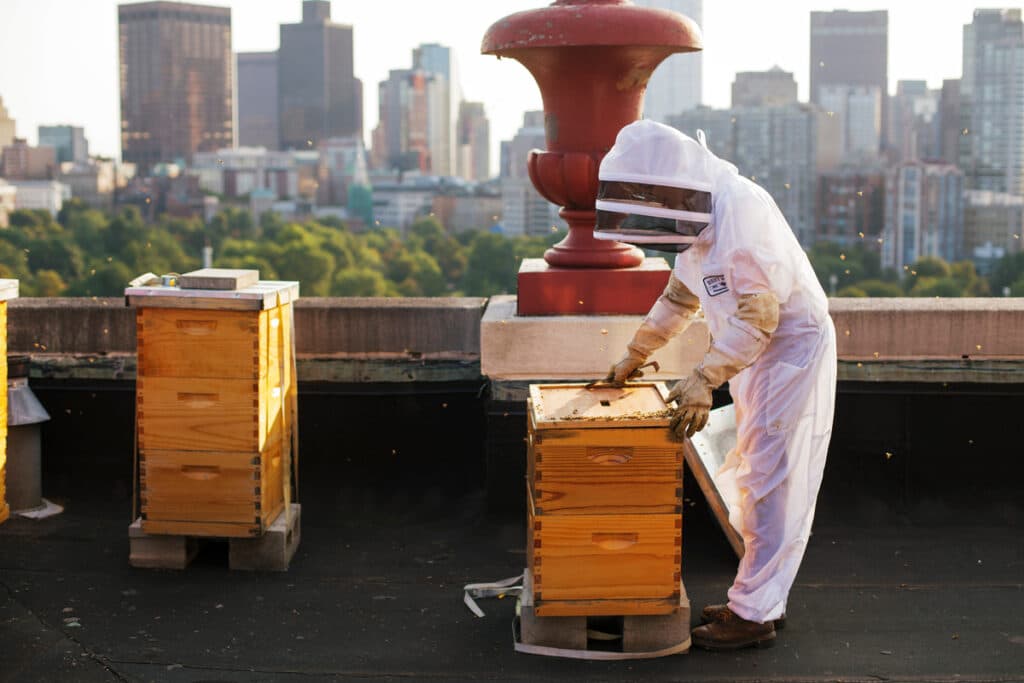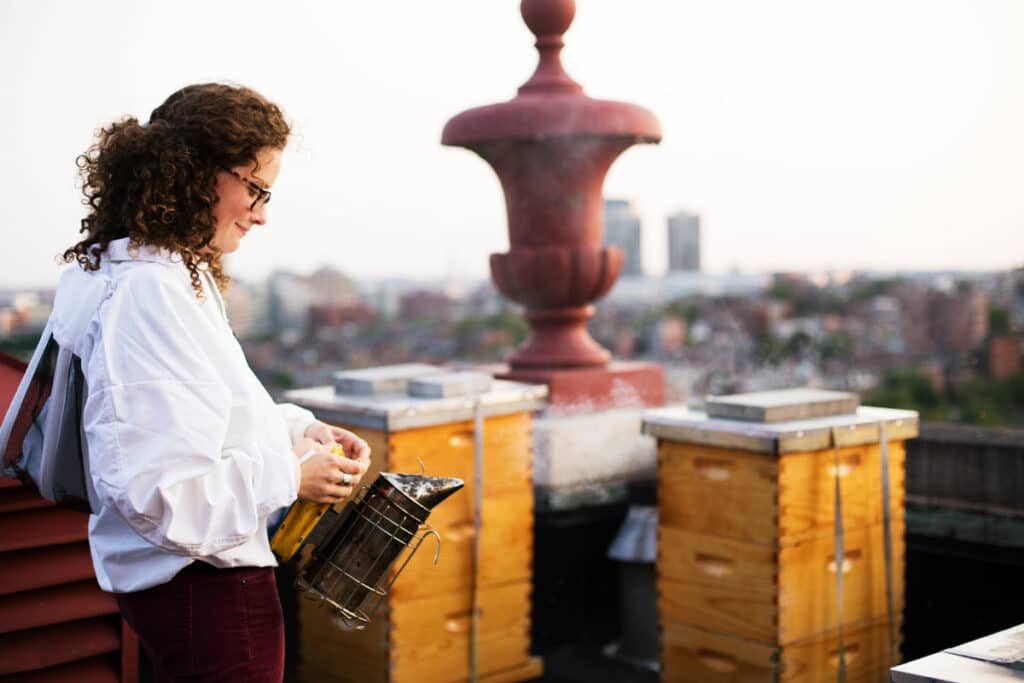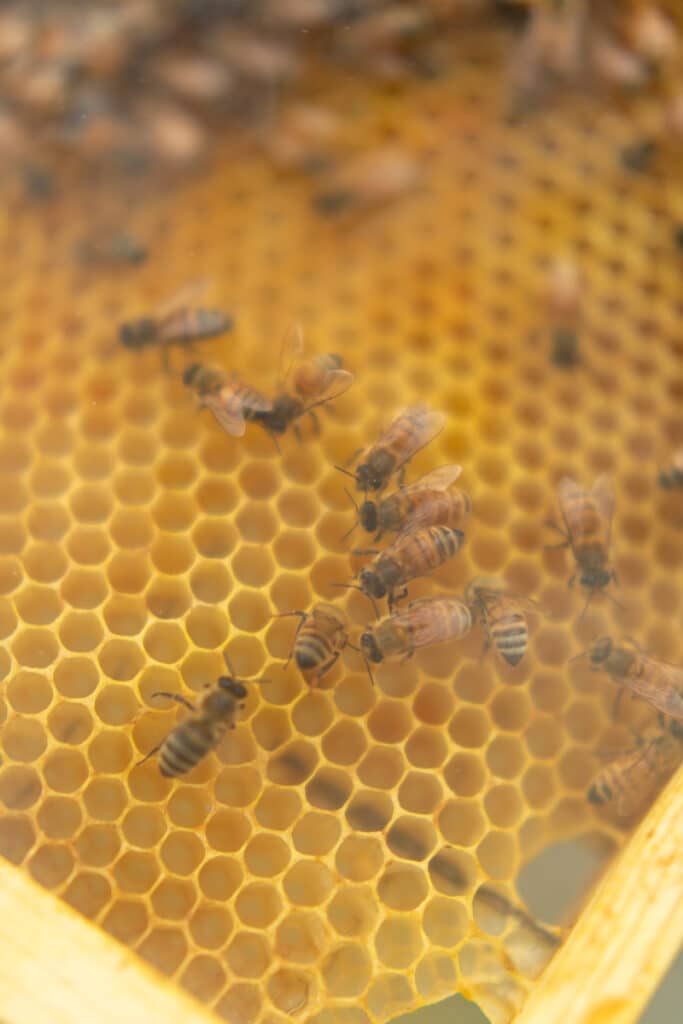There’s a lot of buzz surrounding bees. In recent years, we’ve seen urban beekeeping grow immensely popular in an effort to save bees. But it’s so much more than a trend. Bees enhance garden production. They also add nutritional value to our lives through the foods they pollinate. Vegetated green roofs (or eco-roofs) with pollinator habitats can even earn up to 7 points toward the U.S. Green Building Council’s (USGBC) LEED certification.
What is LEED Certification?
According to the USGBC, LEED (Leadership in Energy and Environmental Design) is the most widely used green building rating system in the world. LEED is for all building types and all building phases including new construction and redevelopments.
Vegetated green roofs (or eco-roofs) with pollinator habitats can even earn up to 7 points toward the U.S. Green Building Council’s (USGBC) LEED certification.
To learn more, here are 5 ways that beehives earn LEED certification points.
Honeybees on a frame.
LEED emphasizes the value of urban gardens and vegetated green roofs. As you begin your sustainability journey, the benefits of having a garden onsite are tenfold, including but not limited to providing fresh produce for community partners, fostering biodiversity, and promoting healthy lifestyle options by implementing in-office corporate wellness programs.
While discussing the many ways The Best Bees Company beehives have been featured in LEED Certification projects with Gautum Tarafdar, an executive with USGBC, we learned that many companies are beginning to focus on health and wellness. Tarafdar noted, “70% of all LEED credits are health and wellness related.”
Green buildings are quickly becoming the new standard for the real estate, development, and urban planning industries. We are seeing many opportunities to go from gray to green on vacant rooftops, redefining a sustainable normal in a post-pandemic world.
According to our resident bee expert, Noah Wilson-Rich, Ph.D., because companies are “incentivized to seek sustainability, with ratings like LEED, we’re seeing tenancy trends in millennials with attitudes that shape where they want to live & work.”
This doesn’t just translate to millennials and employees though. There’s overwhelming support of the sustainability journey from higher-level executives as well. Wilson-Rich explains, “We’re hearing more investor demands for Corporate Social Responsibility (CSR) and Environmental Social and Governance (ESG) requirements. These are extremely common in Europe, and picking up fast here in the States.”
The change we need is toward green rooftops, veggie gardens, playgrounds, and similar amenities, especially given that it has a positive impact on the environment, while also improving your bottom line. Whether you’re planning a redevelopment project or constructing a new building, remember that beehives on an eco-roof can help you accrue credits toward LEED certification and allow you to make a real impact on the health of our planet.

Below are 5 ways that beehives can help you earn your LEED Certification
1. Installing Edible Growing Systems and Beehives for Food Production
Not only does Best Bees partner with gardening services to design, build, and install edible growing systems with beehives, but we also connect you with a team to ensure your urban garden thrives. Earn one point toward LEED Certification by providing a dedicated portion of your site for permanent, onsite food production.
This particular project informs the community about small-scale food production and raises awareness about bees. This opens up the conversation. There’s more education, greater awareness – climate awareness – and hopefully more action.
2. Partnering with Local Food Pantries for Social Equity Within the Community
When starting green building projects, it’s important that an organization first understands its relationships to the impacted community and implement targeted strategies that address social equity. Earn one point toward LEED Certification by completing the Social Economic Environmental Design (SEED) Evaluator tool or by partnering with an existing service/advocacy organization.
This project can improve social equity if you decided to partner with a local, not-for-profit food bank to donate food produced from your rooftop garden. This helps create a fairer, healthier, and more supportive environment for those who work/live in the project
For more information, visit our webpage, Earn LEED Points by Protecting and Promoting Pollinators.
3. Grow Food and Native Plants on Your Green Roof
Beehives and green roofs go hand-in-hand. They both aid in the effort to reduce the effects of climate change. Using native plants to attract pollinators such as bees yield much more growth for your vegetated roofs. This relationship between bees and green roofs limit the amount of surface area that absorbs heat, like cement, and reduces the heat island effect.
This project minimizes the effects on microclimates and human-wildlife habitats by reducing heat islands. Green roofs aid in better air quality and reducing greenhouse gas emissions.
3. Mitigate Habitat Destruction & Promote Biodiversity
Through the use of organic beekeeping practices, Best Bees & our partners such as Vivant Garden Services, Rooftop Roots, and Gardens by Renee choose organic seed varieties native to the onsite property. Earn 2 points toward LEED Certification if your plants are native or adapted, provide habitat, and promote biodiversity.
This project conserves existing natural areas and restores damaged areas to provide habitat and promote biodiversity. This is perfect for your established rooftop garden. Protection and restoration are key components when it comes to caring for thriving, healthy habitats.
We purchase our seeds locally to each pollinator habitat with a preference for native edible plants. Interested in what plants are native to your location? Visit the National Wildlife Federation’s native plant finder.
5. Innovation & The Science of Bees
The Best Bees Company has been operating on commercial buildings for over a decade. In our work with businesses and homeowners, we’ve installed thousands of beehives across the US. These professionally managed beehives are data points that provide valuable insight into the health of bees nationwide. We share this data with partners such as NASA, MIT, and Google Earth to better understand what’s saving the bees, and how that can impact climate change.
You can help too. Each beehive managed by The Best Bees Company brings us one step closer to saving the bees. The more hives we manage, the more data we can gather, the closer we are to our goal—to improve bee health.
Beehives help green building projects achieve exceptional or innovative performance. For people that like to think outside of the frame, you can earn an Innovation LEED credit using a strategy not addressed in the LEED green building rating system.
Your measurable environmental performance must identify the following:
- the intent of the proposed innovation credit;
- proposed compliance requirements;
- proposed submittals to demonstrate compliance; and
- strategies used to meet requirements
More examples of innovation can be found in the LEED Innovation Catalog.
If you believe in a greener future, schedule an assessment with one of our experts today. We look forward to helping you start your sustainability journey.







